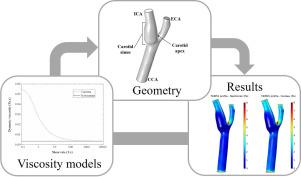European Journal of Mechanics - B/Fluids ( IF 2.6 ) Pub Date : 2020-05-21 , DOI: 10.1016/j.euromechflu.2020.05.010 D. Lopes , H. Puga , J.C. Teixeira , S.F. Teixeira

|
Blood is a complex biological fluid and has elements in its composition, such as erythrocytes, which give it a non-Newtonian behavior. Typically, when carotid blood flow is studied, this aspect is frequently ignored and blood is modeled as a Newtonian fluid, with constant viscosity. This work demonstrates a Fluid–Structure Interaction study of carotid blood flow, with the comparison of two distinct viscosity models (Newtonian and Carreau). The results of the Independent Samples Kolmogorov–Smirnov statistical test show that the velocity in the center of geometry of the is similar for both viscosity models (p = 1.00; p = 0.71; p = 1.00) in the three vessels of the bifurcation Wall Shear Stress is dependent on the blood viscosity (p = 0.027), and is considerably higher for the Carreau model. The displacement of the arterial wall is reliant on the fluid pressure, and it is not influenced by the blood viscosity.
中文翻译:

颈动脉血流的结构相互作用研究:粘度模型之间的比较
血液是一种复杂的生物流体,并且在其组成中具有诸如红细胞之类的元素,从而使其具有非牛顿性行为。通常,在研究颈动脉血流时,经常会忽略此方面,并将血液建模为具有恒定粘度的牛顿流体。这项工作演示了颈动脉血流的结构相互作用研究,并比较了两种不同的粘度模型(牛顿模型和卡洛模型)。独立样本Kolmogorov–Smirnov统计测试的结果表明,在分叉壁剪的三个容器中,两种粘度模型的几何中心速度均相似(p = 1.00; p = 0.71; p = 1.00)。压力取决于血液粘度(p = 0.027),对于Carreau模型,压力要高得多。


























 京公网安备 11010802027423号
京公网安备 11010802027423号